
In the classroom by the sea...
June 16, 1998
West Virginia University
in Vendée, France

In the classroom by the sea...
June 16, 1998
Below, Albert Grambin welcomes the WVU-Vendéens to the house of Georges Clemenceau in Saint Vincent sur Jard, Vendée. Born in Vendée in 1841, Clemenceau was among the most important political figures of his time. A supporter of the establishment a democratic republic after the fall of the Second Empire in 1870, he worked all his life for the ideals of liberty, equality, fraternity. His opposition to all repression of human rights led him in the 1890's to the side of Captain Dreyfus, falsely accused of treason due only to his Judaism. Clemenceau was the only editor in France willing to publish Emile Zola's world famous article "J'Accuse" (title chosen by Clemenceau himself) in which nearly the entire command of the French army was shown to have committed fraud in the conviction of the innocent Dreyfus. From the victory of Drefus' exhoneration, Clemenceau would go on the lead France to victory in World War I, thus earning one of his nicknames, "le Père de la Victoire" ("the Father of Victory").
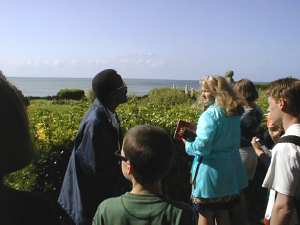
Clemenceau moved into his house on the coast of his native Vendée in 1920, after
resigning from his turbulent career in politics, journalism, and diplomacy. Below,
Albert opens a gaming table on which Clemenceau and his friends played in his later years.
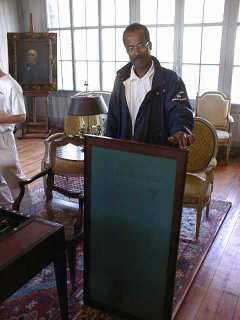
Very early in his career, Clemenceau's tenacious politics and uncanny ability to
destroy his ennemies had earned him the nicknames of "Tombeur de Ministères"
("government blaster") and "Tigre" (Tiger). Below, we see a
portrait of the figurative "Tiger" and the skin of a real tiger he hunted down
during the travels of his later years.
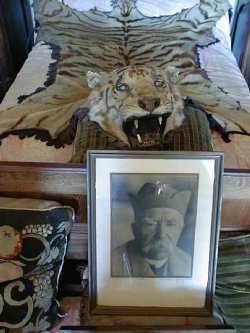
Before his death in 1929, Clemenceau developed a passion for the world of the
Far East and a special friendship with the Emperor Hirohito of Japan. Below is
the one of many gifts from Hirohito to a man who little suspected that in years to come
Japan would unite with the very Germany Clemenceau had worked to defeat in a world war of
proportions unknown even to this "Father of Victory".
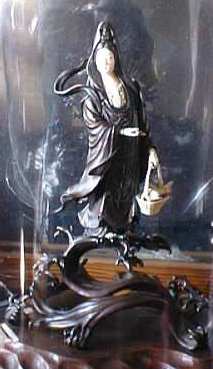
Here is the funeral mask of Clemenceau, along with a plaster of his hand in the glove that he used in the attempt to heal his chronic exzema.
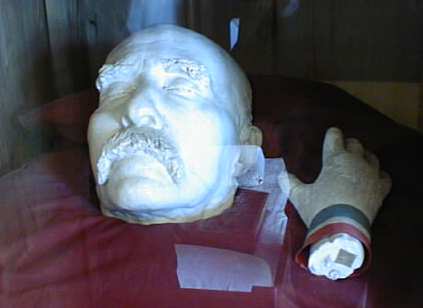
In remembrance of the victory that brought back the cherished provinces of Alsace
and Lorraine to the French Republic, Clemenceau decorated the walls of his kitchen with
ceramic tiles from thes eastern French regions.
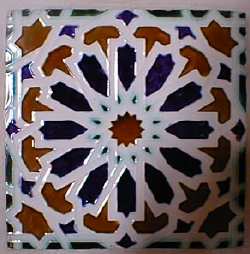
Below is the kitchen of Clemenceau's intimate country house, with its copper
pots on the cupboard and the clock stopped at 1:45 am, November 24, 1929 -- the hour of
the Tiger's death.
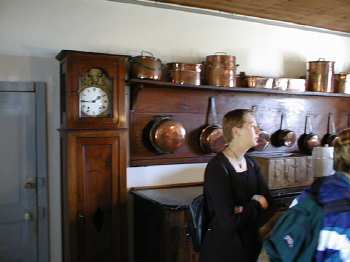
Clemenceau in renovating the simple coastal house he bought for his retirement worked the miracle of bringing forth a beautiful Impressionist garden on the model of that of his best friend, the painter Claude Monet.
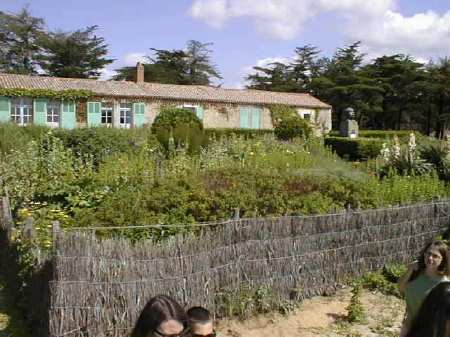
After our visit of the Clemenceau house, the WVU-V students enjoy a few minutes on the beach where Clemenceau himself took his repose some 70 years ago. After an exceptionally cool beginning of June, the weather is at last becoming pleasant enough for everyone to get a taste of true Vendée weather.
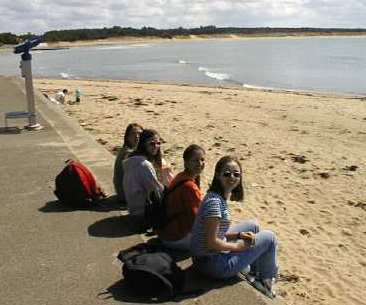
After a quick lunch back in Les Sables, we are on the bus to the CAIRN (Centre Archéologique d'Initiation à la Recherche sur le Néolithique), where we will explore the culture not of the last century but of those 4500 years before Christ. Below, our guide John Ferré (a true Vendéen despite his English forename), intrduces us to a region and a period of time that are truly in his heart. We will soon visit the "Dolmen" pictured to John's right (our left).
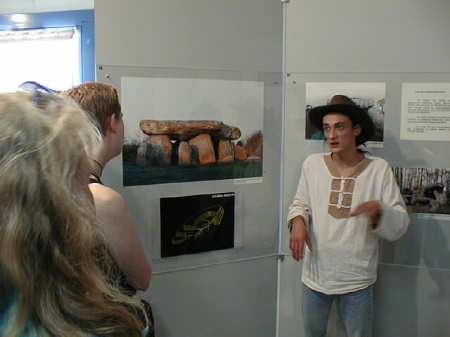
John enters here into a plexiglass cage, where he demonstrates the various tools of the neolithic age, including the dangerous (for bystanders) process of making tools from raw flint.
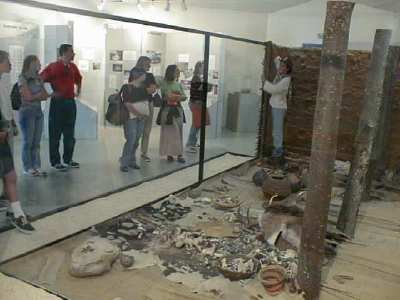
Here John, stationed before the Center's own "cairn" (stone
building) has made fire using a bow, two pieces of wood, and some dried grass.
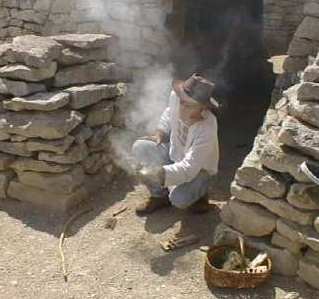
The WVU-Vendéens dare the spirits by entering into the cairn, which was conceived as a stone receptacle for the remains of the ancient dearly departed.
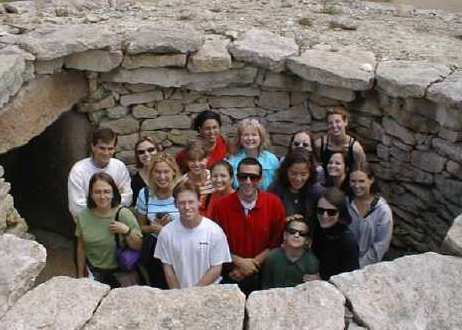
The WVU-Vendéens now venture into an authentic "dolmen". In
its day this dolmen was the central cavity of an immense stone structure where its
prehistoric builders buried their dead. Depending on the ages, almost all such
structures in Europe have been dismantled, either in an effort to stamp out the religions
associated with them or simply in order to use their stones in the contruction of castles,
churches, or simple farm houses.
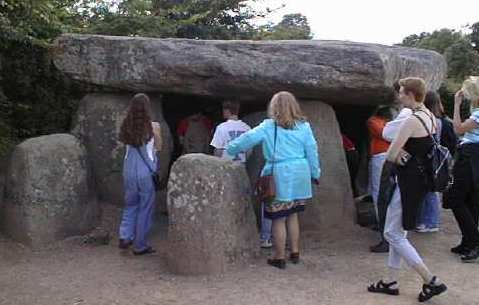
Here our WVU-Vendéens are in an ancient tomb, one older than the pyramids of
Egypt. These are in fact the oldest man-made monuments on earth.
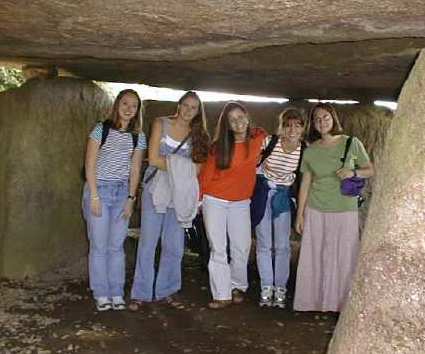
Amanda Walker climbs on to the rough of the dolmen and demonstrates athletic abilities that would surely impress the any stone-age athlete.
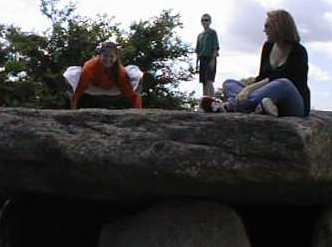
While we know that the "dolmens" were ancient tombs, we still do not understand the function of the "menhir", the single giant stones that once dotted much of Europe and which now remain in only a few isolated areas. Whatever their function, it is almost impossible to conceive the effort necessary to raise a stone of many hundreds of tons to the position we see below.
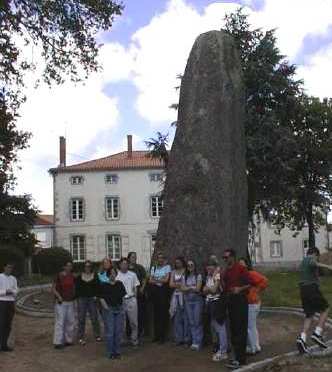
Stay tuned to WVU-V!
Go on to June 17. 1998.